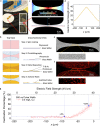Operando investigation of the synergistic effect of electric field treatment and copper for bacteria inactivation
- PMID: 38355666
- PMCID: PMC10867087
- DOI: 10.1038/s41467-024-45587-3
Operando investigation of the synergistic effect of electric field treatment and copper for bacteria inactivation
Abstract
As the overuse of chemicals in our disinfection processes becomes an ever-growing concern, alternative approaches to reduce and replace the usage of chemicals is warranted. Electric field treatment has shown promising potential to have synergistic effects with standard chemical-based methods as they both target the cell membrane specifically. In this study, we use a lab-on-a-chip device to understand, observe, and quantify the synergistic effect between electric field treatment and copper inactivation. Observations in situ, and at a single cell level, ensure us that the combined approach has an enhancement effect leading more bacteria to be weakened by electric field treatment and susceptible to inactivation by copper ion permeation. The synergistic effects of electric field treatment and copper can be visually concluded here, enabling the further study of this technology to optimally develop, mature, and scale for its various applications in the future.
© 2024. The Author(s).
Conflict of interest statement
The authors declare no competing interests.
Figures




Similar articles
-
Operando Investigation of Locally Enhanced Electric Field Treatment (LEEFT) Harnessing Lightning-Rod Effect for Rapid Bacteria Inactivation.Nano Lett. 2022 Jan 26;22(2):860-867. doi: 10.1021/acs.nanolett.1c02240. Epub 2021 Nov 4. Nano Lett. 2022. PMID: 34734724
-
Rapid determination of the electroporation threshold for bacteria inactivation using a lab-on-a-chip platform.Environ Int. 2019 Nov;132:105040. doi: 10.1016/j.envint.2019.105040. Epub 2019 Aug 3. Environ Int. 2019. PMID: 31387020
-
Tuning the Locally Enhanced Electric Field Treatment (LEEFT) between Electrophysical and Electrochemical Mechanisms for Bacteria Inactivation.Environ Sci Technol. 2024 Aug 20;58(33):14875-14885. doi: 10.1021/acs.est.4c00503. Epub 2024 Aug 6. Environ Sci Technol. 2024. PMID: 39105772 Free PMC article.
-
[Current situation and problems associated with inactivation of microorganisms in water using copper].Nihon Koshu Eisei Zasshi. 2013 Sep;60(9):579-85. Nihon Koshu Eisei Zasshi. 2013. PMID: 24125817 Review. Japanese.
-
Pulsed electric field inactivation of microorganisms: from fundamental biophysics to synergistic treatments.Appl Microbiol Biotechnol. 2019 Oct;103(19):7917-7929. doi: 10.1007/s00253-019-10067-y. Epub 2019 Aug 7. Appl Microbiol Biotechnol. 2019. PMID: 31392376 Review.
Cited by
-
Water Disinfection Systems for Pools and Spas: Advantages, Disadvantages, and Consumer Views in the US.ACS ES T Water. 2025 Jan 9;5(2):525-538. doi: 10.1021/acsestwater.4c00612. eCollection 2025 Feb 14. ACS ES T Water. 2025. PMID: 39974564 Free PMC article. Review.
References
-
- Mitch WA, Richardson SD, Zhang X, Gonsior M. High-molecular-weight by-products of chlorine disinfection. Nat. Water. 2023;1:336–347. doi: 10.1038/s44221-023-00064-x. - DOI
-
- Baig, M. I. R. et al. Mechanisms of emerging resistance associated with non-antibiotic antimicrobial agents: a state-of-the-art review. The Journal of Antibiotics10.1038/s41429-023-00649-4 (2023). - PubMed
MeSH terms
Substances
Grants and funding
LinkOut - more resources
Full Text Sources
Research Materials
Miscellaneous

